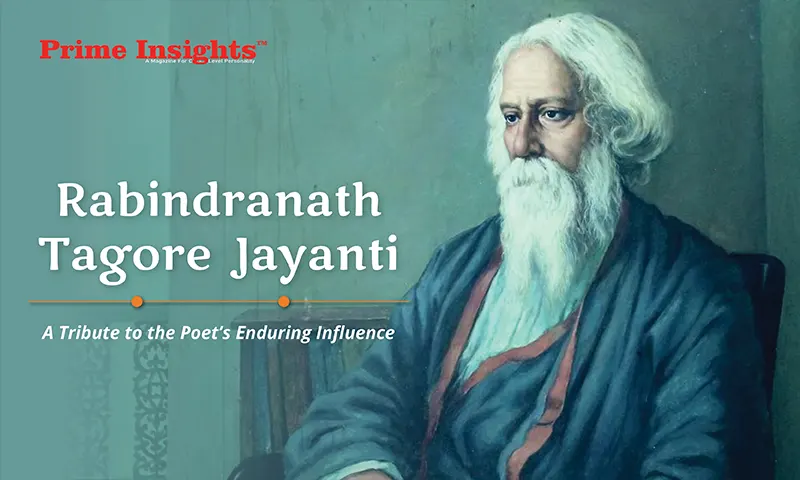Rabindranath Tagore Jayanti
“I’m lost in the middle of my birthday. I want my friends, their touch, with the earth’s last love. I will take life’s final offering, I will take the human’s last blessing. Today my sack is empty. I have given completely whatever I had to give. In return, if I receive anything—some love, some forgiveness—then I will take it with me when I step on the boat that crosses to the festival of the wordless end.”
– Rabindranath Tagore
Rabindra Jayanti is celebrated every year in May, on the 25th day of the Bengali month of Boishakh, because, as per the Bengali calendar, Rabindranath Tagore was born on this day of the year 1268, and as per the Gregorian calendar, he was born on May 7, 1861.
The Bard of Bengal, Rabindranath Tagore, was a very famous poet, playwright, composer, philosopher, writer, painter, and much more in the age of the Bengal Renaissance. He was popularly known as Gurudeb, Kobiguru, and Biswokobi. In 1913, he was the first non-European to win the Nobel Prize in Literature.
Kobiguru was born to Debendranath Tagore and Sarada Devi at 7 Dwarakanath Tagore Lane in North Kolkata. His mother died at a very young age, so he was mostly raised by servants. He was the 9th child of the 13 children born to Debendranath. His eldest brother, Dwijendranath, was a poet and a philosopher; his other brother, Satyendranath, was a talented composer and musician; and his sister, Swarnakumari, was a novelist herself.
Rabindranath Tagore was not fond of classroom teaching. His brother Hemendranath tutored and physically conditioned him by making him trek through hills, swim in the Ganga, do gymnastics, practice judo, and wrestle. And she also taught him to draw and tutored him in geography, history, literature, mathematics, and other subjects like Sanskrit and English.
At the age of 11, Rabindranath Tagore and his father left Calcutta to travel all over India, which made him very curious about the cultures of the various states. For example, when he was in Amritsar, he was highly influenced by Gurbani and Nanak Bani, which were sung at the Golden Temple, which he visited daily with his father. He wrote various poems and articles related to Sikhism in the children’s magazine of Bengal, like poems on Guru Gobind Singh, a poem on Banda Bahadur, a poem on Bhai Torusingh, and a poem on Nihal Singh.
He was sent to England to study and become a barrister with his nephew and niece, Suren and Indira Devi. There he briefly enrolled himself to study law at the University College London, but again he opted out and went for independence study. After he returned to Bengal degree less in 1880, he regularly wrote road stories, poems, and novels. This will impact the whole of Bengal and catch the nation’s attention. In 1883, he was married to Mrinalini Devi. He was very close to his sister-in-law, Kadambari Devi, who was his very dear friend but committed suicide in 1884, which caused him a lot of distress. In 1819, Tagore left to manage his ancestor’s estate in Bangladesh with his wife and children. He released one of his famous poems, Manasi.
In the year 1901, Rabindranath Tagore founded an experimental school, Visva-Bharati Mandir, in Shantiniketan Ashram, surrounded by a lot of trees, gardens, and a library. In 1912, Rabindranath Tagore started translating his Gitanjali in English while on a trip to London. He shared his poems with his admirers, including Ezra Pound and William Butler Yeats. His poetry from Gitanjali was published in an American magazine called Poetry. After being awarded the Nobel Prize in 1913, he was also awarded the knighthood, which he later renounced due to the massacre in Jalianwala Bagh in 1919.
Some of his famous works are Manasi (1890), Gitanjali (1910), Gora (1910), Ghare-Baire (1916), etc. Jana Gana Mana was composed by him on December 11, 1911, and was adopted as the national anthem of India. In 1971, Amar Shonar Bangla was announced as the national anthem of Bangladesh. Even Sri Lanka’s national anthem was inspired by his work.
At the age of 60, he started drawing and painting and was successful in exhibiting some of his works. His painting suggested that he was likely red and green color blind.
Rabindranath Tagore Jayanti is celebrated every year in remembrance of the contribution of Kobiguru. On this day, numerous cultural programs and events are held, where people celebrate by singing Rabindra Sangeet, reciting his poems and dances, and acting on the dramas written and composed by Kobiguru. It is a day to pay tribute to the Biswokobi’s enduring influence on literature.

